Abstract
Finding a path between two vertices of a given graph is one of the most classic problems in graph theory. Recently, problems of finding a route avoiding forbidden transitions, that is, two edges that cannot be passed through consecutively, have been studied. In this paper, we introduce the ordered variants of these problems, namely the Path Avoiding Ordered Forbidden Transitions problem (PAOFT for short) and the Trail Avoiding Ordered Forbidden Transitions problem (TAOFT for short). We show that both the problems are NP-complete even for bipartite planar graphs with maximum degree three. Since the problems are solvable for graphs with maximum degree two, the NP-completeness results are tight with respect to the maximum degree of a graph. Furthermore, we show that TAOFT remains NP-complete for cactus graphs. As positive results of PAOFT, we give a polynomial-time algorithm for bounded treewidth graphs and a linear-time algorithm for cactus graphs.
A. Suzuki—Partially supported by JSPS KAKENHI Grant Number JP20K11666, Japan.
Y. Tamura—Partially supported by JSPS KAKENHI Grant Number JP21K21278, Japan.
X. Zhou—Partially supported by JSPS KAKENHI Grant Number JP19K11813, Japan.
Access this chapter
Tax calculation will be finalised at checkout
Purchases are for personal use only
Similar content being viewed by others
Notes
- 1.
In [5], only a sketch of the algorithm was given. For more details, see a full version from the following URL: https://inria.hal.science/hal-01115395/file/PAFT.pdf.
- 2.
A set of ordered forbidden transitions for \(G^\prime \) can be constructed by scanning \(\mathcal {F}\) and removing redundant transitions from \(\mathcal {F}\) in \(O(|\mathcal {F}|)\) time. Then, PAOFT on \(G^\prime \) can be solved in O(n) time.
References
Bellitto, T., Li, S., Okrasa, K., Pilipczuk, M., Sorge, M.: The complexity of routing problems in forbidden-transition graphs and edge-colored graphs. Algorithmica 85(5), 1202–1250 (2023). https://doi.org/10.1007/s00453-022-01064-1
Bodlaender, H.L., Kloks, T.: Efficient and constructive algorithms for the pathwidth and treewidth of graphs. J. Algorithms 21(2), 358–402 (1996). https://doi.org/10.1006/jagm.1996.0049
Hopcroft, J., Tarjan, R.: Algorithm 447: efficient algorithms for graph manipulation. Commun. ACM 16(6), 372–378 (1973). https://doi.org/10.1145/362248.362272
Kanté, M.M., Laforest, C., Momège, B.: An exact algorithm to check the existence of (elementary) paths and a generalisation of the cut problem in graphs with forbidden transitions. In: van Emde Boas, P., Groen, F.C.A., Italiano, G.F., Nawrocki, J., Sack, H. (eds.) SOFSEM 2013. LNCS, vol. 7741, pp. 257–267. Springer, Heidelberg (2013). https://doi.org/10.1007/978-3-642-35843-2_23
Kanté, M.M., Moataz, F.Z., Momège, B., Nisse, N.: Finding paths in grids with forbidden transitions. In: Mayr, E.W. (ed.) WG 2015. LNCS, vol. 9224, pp. 154–168. Springer, Heidelberg (2016). https://doi.org/10.1007/978-3-662-53174-7_12
Karp, R.M.: Reducibility among combinatorial problems. In: Miller, R.E., Thatcher, J.W., Bohlinger, J.D. (eds.) Complexity of Computer Computations, pp. 85–103. Springer (1972). https://doi.org/10.1007/978-1-4684-2001-2
Kotzig, A.: Moves without forbidden transitions in a graph. Matematický časopis 18(1), 76–80 (1968). https://eudml.org/doc/33972
Nguyên, L.T.D.: Unique perfect matchings, forbidden transitions and proof nets for linear logic with Mix. Logical Methods in Computer Science 16(1) (2020). https://doi.org/10.23638/LMCS-16(1:27)2020
Szeider, S.: Finding paths in graphs avoiding forbidden transitions. Discret. Appl. Math. 126(2), 261–273 (2003). https://doi.org/10.1016/S0166-218X(02)00251-2
Acknowledgements
We thank the referees for their valuable comments and suggestions which greatly helped to improve the presentation of this paper.
Author information
Authors and Affiliations
Corresponding author
Editor information
Editors and Affiliations
Rights and permissions
Copyright information
© 2024 The Author(s), under exclusive license to Springer Nature Switzerland AG
About this paper
Cite this paper
Kumakura, K., Suzuki, A., Tamura, Y., Zhou, X. (2024). On the Routing Problems in Graphs with Ordered Forbidden Transitions. In: Wu, W., Tong, G. (eds) Computing and Combinatorics. COCOON 2023. Lecture Notes in Computer Science, vol 14422. Springer, Cham. https://doi.org/10.1007/978-3-031-49190-0_26
Download citation
DOI: https://doi.org/10.1007/978-3-031-49190-0_26
Published:
Publisher Name: Springer, Cham
Print ISBN: 978-3-031-49189-4
Online ISBN: 978-3-031-49190-0
eBook Packages: Computer ScienceComputer Science (R0)




